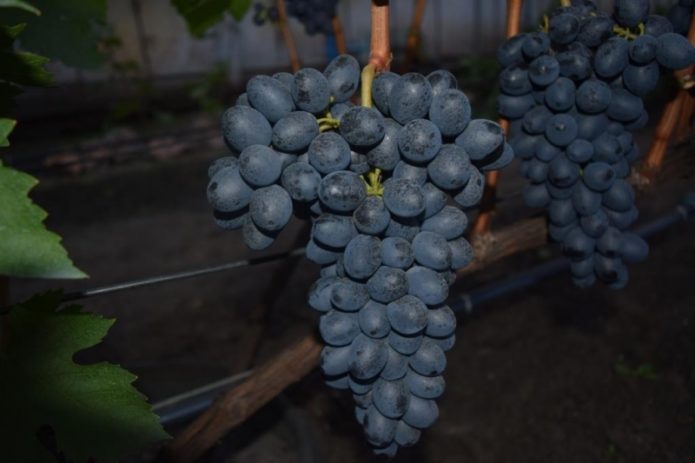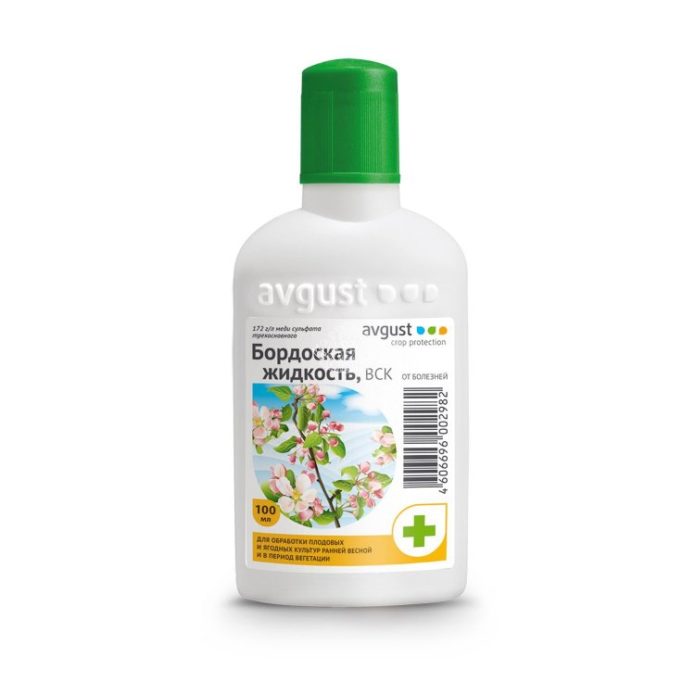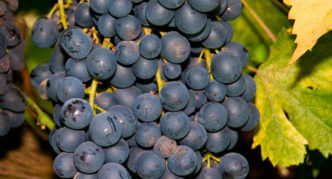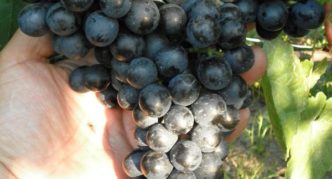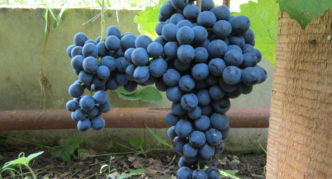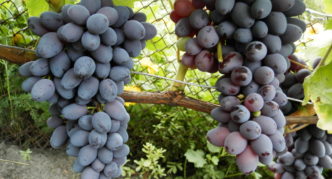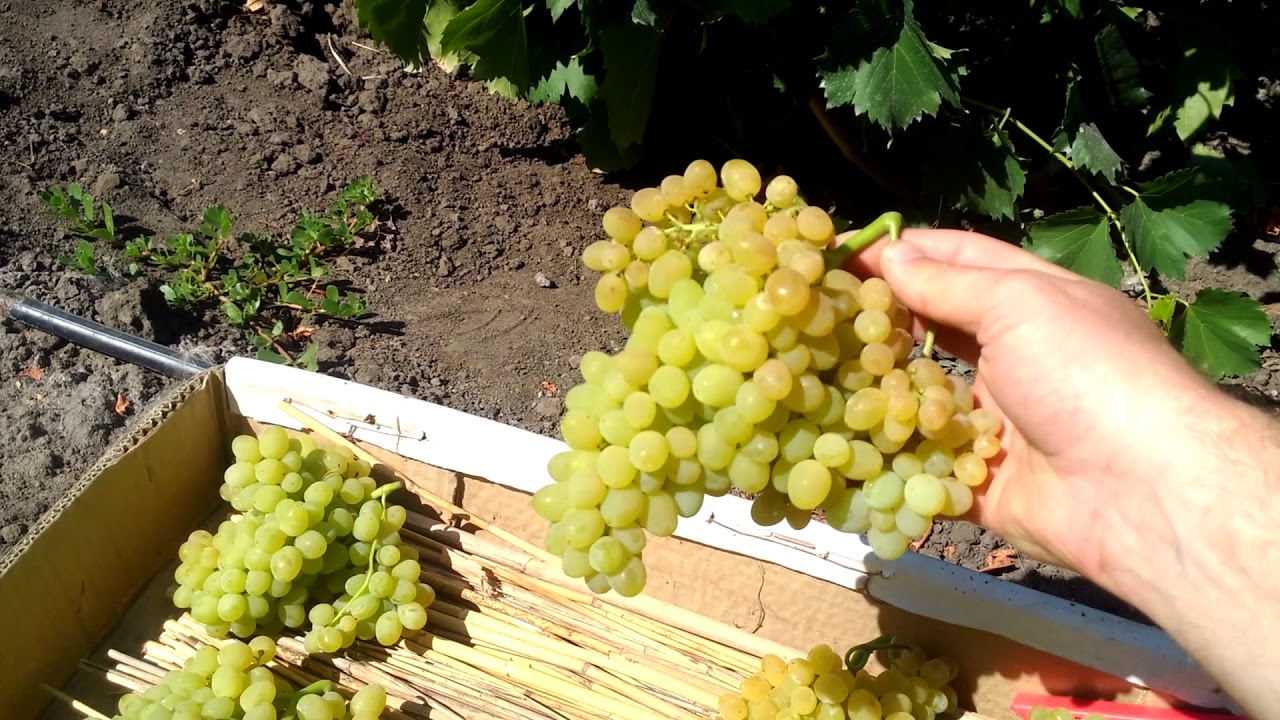Attica is a popular early-ripening seedless grape. It is grown equally successfully by small-plot owners and farmers engaged in industrial viticulture. Why is Attica so attractive to them and how to get bountiful harvests from her without much trouble?
Content
The history of breeding and description of the Attica grape variety
The Attica grape was obtained by the Greek breeder Mihos Vassilos by hybridizing the varieties Alphonse Lavalle and Kishmish black. The date of birth of Attica is 1979. Over the past decades, the variety has become widespread in many countries of the world.
In our country, Attica appeared only in the early 2000s. Despite such a short period of time, today it is grown by many winegrowers. The Attica variety is especially appreciated by farmers who grow grapes on an industrial scale.
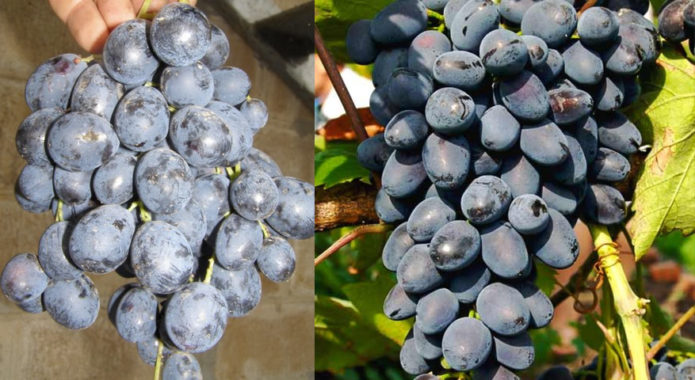
The Attica variety combines the best qualities of the parent varieties: Alphonse Lavalle and Black Kishmish
Attica is an early-maturing table seedless grape. Its berries reach removable maturity 118–120 days after the leaves bloom. In the Rostov region, this period usually falls on the second decade of August, in more northern regions - at the beginning of September.
The growth vigor of the bushes of Attica is above average. Their shoots ripen well, and bisexual flowers are perfectly pollinated even in bad weather. Among the advantages of this variety is its high compatibility with all common rootstocks.
Rounded, large purple Attica berries are collected in cylindrical, sometimes with wings, clusters up to 30 cm long and weighing 600-900 g. The flesh is firm, crispy. The skin is thick but easily eaten. The taste is pleasant, not astringent, without a pronounced aroma. According to winegrowers, it improves significantly when the bunches are overexposed on the bush. Rudiments of seeds in fruits are rare. The sugar content of this variety is about 18%, with an acidity of less than 5%.
The average yield in Attica ranges from 25 to 30 tons per hectare. Its fruits are distinguished by good transportability and keeping quality. Even with long-term storage, they are not affected by rot and practically do not lose weight, and the crests of the bunches change their color only in the second week after collection. Berries of this variety are most often eaten fresh, but some growers use it to dry and prepare wine.
Attica does not tolerate frosts below -15-18 ° C. It is quite resistant to gray rot of the fruit, but is affected by other fungal diseases at the level of standard grape varieties.
Video: an overview of the Attica variety
Growing features
Agrotechnology of the Attica grapes differs little from the activities carried out in the cultivation of other grape varieties. Planting, watering, fertilizing and shaping the bushes is carried out according to standard crop patterns. But there are still some features in caring for the Attica variety.
- For grafting Attica cuttings, it is recommended to choose tall rootstocks.
- Like any high-yielding variety, Attica needs crop rationing. In order to avoid deterioration of the commercial qualities of the berries and the general weakening of the bush, 1-2 clusters are left on each shoot, and all the rest are removed immediately after flowering and pollination.
- The average resistance of Attica to fungal infections forces winegrowers to regularly treat its plantings with fungicides (Bordeaux liquid, copper sulfate, Kuprozan, Fundazol). For prevention, 2 sprays per season are usually sufficient.
- Attica grapes often suffer from attacks by wasps, who do not miss the chance to feast on sweet berries. Protecting the crop is easiest with fine mesh pouches that are worn over the pouring bunches. Wasp traps are also very effective. It's pretty easy to make them yourself. It is enough to cut off the upper part and insert it back into the lower part. Then the resulting container is filled with a solution of honey, sugar syrup or beer and left next to the grape bushes.
- Due to the low frost resistance in almost all regions of Russia, with the exception of the southernmost ones, Attica grapes are covered for the winter. For this, the shoots are removed from the support, tied and laid on the ground. From above, the plants are insulated with any material that allows air to pass through well. Most often, growers use spruce branches, straw or burlap. The so-called non-woven material (lutrasil or spunbod) is also suitable for shelter.
Advantages and Disadvantages of Attica Grapes Compared to Other Seedless Varieties
Attica is far from the only seedless black-fruited grape with an early maturity. In order not to be disappointed in choosing a crop for our site, let us compare the main characteristics of similar varieties.
Table: Popular, early-ripening seedless black-fruited grape varieties
| Variety name | Ripening period (days from the beginning of the growing season) | Yield | Winter hardiness (° C) | Disease resistance | Bunch weight (g) | Average weight of berries (g) | Berry flavor | Sugar content |
| Attica | 118–120 | 250-300 c / ha | -15–18 | Resistant to gray mold, susceptibility to other fungal diseases - at the level of standard varieties | 600–900 | 4–5 | Neutral, pleasant | 16–18 |
| Black Emerald (Kishmish Black Emerald) | 95–105 | High | -23 | Poorly resistant to fungal diseases, may suffer from fruit cracking | Up to 500 | 3–5 | Harmonious | 18 |
| Venus | 120 | 200-250 c / ha | -26 | Resistant to powdery mildew (2 points), mildew (2.5 points) and fruit cracking, but can be affected by gray mold. | from 200 | 2–3 | Harmonious, with a light strawberry-nutmeg aroma | 18–20 |
| Memory Dombkovskaya (Black seedless winter hardy) | 110–115 | 87.3 c / ha | -28 | Increased | from 200 to 500 (sometimes more than 1 kg) | Up to 2.5 | Plain | 18,6 |
| Kishmish Black Sultan | 115–120 | -25 | Relatively resistant to mildew, powdery mildew and gray mold | 300 (sometimes up to 700) | 2,2–2,8 | Pleasant, with a light fruity aroma | 18–24 | |
| Jupiter | 101 | 200–250 | -27 | Medium resistant to fungal infections, practically does not suffer from cracking of berries | 200–250 | 4–5 | Good, with a complex strawberry-nutmeg aroma | Up to 21 |
Photo gallery: grape varieties similar in quality to Attica
- The length of Black Emerald grapes can be up to 20 cm
- The Venus grape was developed in the United States in the late 70s.
- Memory Dombkovskaya - a winter-hardy variety of Russian selection
- In southern Russia Kishmish the Black Sultan ripens in mid-August
- The Jupiter grape variety grows well and bears fruit in regions with cool climates
As can be seen from the table, Attica is inferior to many varieties of seedless black-fruited grapes in terms of resistance to frost and fungal infections. Nor does it possess outstanding taste. But in terms of yield, as well as the size of bunches and berries, Attica has no equal. These qualities provide the variety with a fairly high popularity among winegrowers in many countries.
Reviews of experienced winegrowers from different regions about the Attica variety
Report on the first fruiting of Attica at the time of ripening. The bush is 2 years old, the load is 4 clusters of 0.5–0.6 kg each. On August 19, it reached a removable maturity, but for the development of the taste, I think it still needs to hang. The berry, as expected, weighs up to 5.4 grams, the bulk of the berries weighs about 4 grams. All berries weighing up to 4 grams are seedless (rudiments are not felt at all), but those that are larger turned out with rudiments, the average weight of one rudiment from large berries is 25 mg. When biting through, the rudiments are slightly bitter, but chewed. Let's see, while they are green and soft, suddenly start to brown?
Perhaps the taste is not very good for Spets, but for me it is even very good. Now all markets in the Krasnodar Territory are filled with Attica - the average price is 100 rubles. Its popularity this year is the same as that of Pleven, but it is more expensive than Arcadia. And what is interesting, the one that was sold before was really not a very simple taste - and the current one that is sold in September is very tasty. And they say that Attica is better vaccinated. I will plant it for myself - good dark, large raisins!
Today, the first smaller cluster of Attica was cut, there are 3 of them in total, the first fruiting, growing in a p / c greenhouse. Wonderful quiche-mish, no bones, soft rudiments come across, the skin is dense, does not crack, fleshy, sweet, but with sourness, very pleasant taste. I don’t know about long-term storage, I didn’t store it, but it seemed to me that it would lie down for a while. The berry does not fall off the bunch, holds tight and sometimes comes off with the meat. Those. will hardly crumble. I liked. I want to have another bush and make raisins out of it.
The wine from Attica turns out not bad. It was even sold at the exhibition, they took a bottle out of interest. The houses tried it, and were satisfied.
I tried raisins from Attica raisins today. In this form, I liked it more than fresh. Normul! Of course, we cannot compete with southern raisins! But this is yours.
Attica gave the first harvest - cut 2 buckets from a 3-year-old bush ... Apparently overloaded it a little, ripened by September 10. I took the last 2 bunches yesterday. The maximum berry weight is 6.1 g. The taste is not outstanding, but very rich (as winemakers say - a lot of body). After 2x professional mildew treatments - everything is clean.
Despite its Mediterranean roots, the Attica grape has successfully taken root in Russia and Ukraine. Of course, due to the low winter hardiness in many regions, Attica needs shelter for the winter, but this does not deter lovers of tasty and healthy berries of a beautiful dark purple color.
